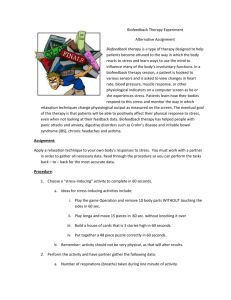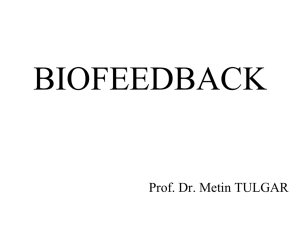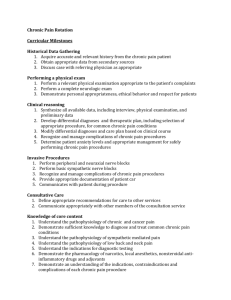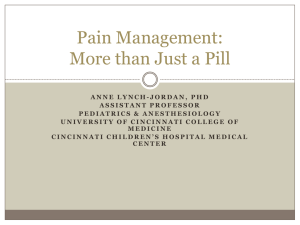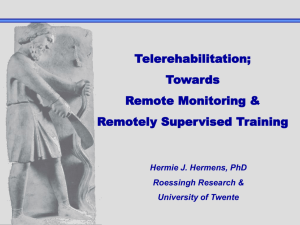Pain Efficacy - ADNC Neurofeedback Centre of BC
advertisement
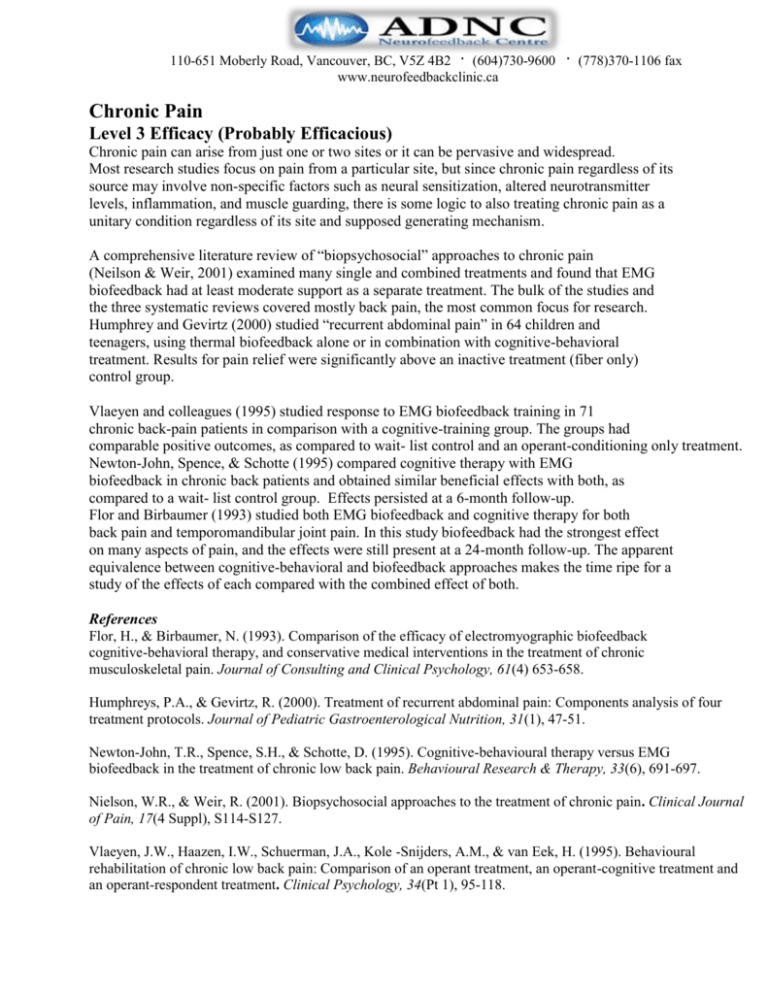
110-651 Moberly Road, Vancouver, BC, V5Z 4B2 · (604)730-9600 · (778)370-1106 fax www.neurofeedbackclinic.ca Chronic Pain Level 3 Efficacy (Probably Efficacious) Chronic pain can arise from just one or two sites or it can be pervasive and widespread. Most research studies focus on pain from a particular site, but since chronic pain regardless of its source may involve non-specific factors such as neural sensitization, altered neurotransmitter levels, inflammation, and muscle guarding, there is some logic to also treating chronic pain as a unitary condition regardless of its site and supposed generating mechanism. A comprehensive literature review of “biopsychosocial” approaches to chronic pain (Neilson & Weir, 2001) examined many single and combined treatments and found that EMG biofeedback had at least moderate support as a separate treatment. The bulk of the studies and the three systematic reviews covered mostly back pain, the most common focus for research. Humphrey and Gevirtz (2000) studied “recurrent abdominal pain” in 64 children and teenagers, using thermal biofeedback alone or in combination with cognitive-behavioral treatment. Results for pain relief were significantly above an inactive treatment (fiber only) control group. Vlaeyen and colleagues (1995) studied response to EMG biofeedback training in 71 chronic back-pain patients in comparison with a cognitive-training group. The groups had comparable positive outcomes, as compared to wait- list control and an operant-conditioning only treatment. Newton-John, Spence, & Schotte (1995) compared cognitive therapy with EMG biofeedback in chronic back patients and obtained similar beneficial effects with both, as compared to a wait- list control group. Effects persisted at a 6-month follow-up. Flor and Birbaumer (1993) studied both EMG biofeedback and cognitive therapy for both back pain and temporomandibular joint pain. In this study biofeedback had the strongest effect on many aspects of pain, and the effects were still present at a 24-month follow-up. The apparent equivalence between cognitive-behavioral and biofeedback approaches makes the time ripe for a study of the effects of each compared with the combined effect of both. References Flor, H., & Birbaumer, N. (1993). Comparison of the efficacy of electromyographic biofeedback cognitive-behavioral therapy, and conservative medical interventions in the treatment of chronic musculoskeletal pain. Journal of Consulting and Clinical Psychology, 61(4) 653-658. Humphreys, P.A., & Gevirtz, R. (2000). Treatment of recurrent abdominal pain: Components analysis of four treatment protocols. Journal of Pediatric Gastroenterological Nutrition, 31(1), 47-51. Newton-John, T.R., Spence, S.H., & Schotte, D. (1995). Cognitive-behavioural therapy versus EMG biofeedback in the treatment of chronic low back pain. Behavioural Research & Therapy, 33(6), 691-697. Nielson, W.R., & Weir, R. (2001). Biopsychosocial approaches to the treatment of chronic pain. Clinical Journal of Pain, 17(4 Suppl), S114-S127. Vlaeyen, J.W., Haazen, I.W., Schuerman, J.A., Kole -Snijders, A.M., & van Eek, H. (1995). Behavioural rehabilitation of chronic low back pain: Comparison of an operant treatment, an operant-cognitive treatment and an operant-respondent treatment. Clinical Psychology, 34(Pt 1), 95-118. 110-651 Moberly Road, Vancouver, BC, V5Z 4B2 · (604)730-9600 · (778)370-1106 fax www.neurofeedbackclinic.ca
